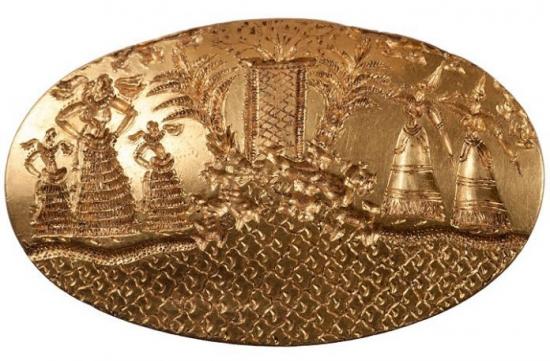Source - https://knowridge.com/2016/12/lord-of-the-rings-archaeologists-unveil-new-findings-from-greek-warriors-tomb/
 A University of Cincinnati team’s rare discovery of four gold rings in the tomb of a wealthy Bronze Age warrior undisturbed for 3,500 years prompts a new consideration of Greek history.
A University of Cincinnati team’s rare discovery of four gold rings in the tomb of a wealthy Bronze Age warrior undisturbed for 3,500 years prompts a new consideration of Greek history.
When University of Cincinnati researchers uncovered the tomb of a Bronze Age warrior — left untouched for more than 3,500 years and packed with a spectacular array of precious jewelry, weapons and riches — the discovery was hailed by experts as “the find of a lifetime.”
Now, only a year after the excavation, new understandings of the artifacts — particularly the discovery of four golden rings — may prove to be the team’s next big discovery.
Shari Stocker, a senior research associate in UC’s Department of Classics, revealed the findings at The American School of Classical Studies at Athens, Greece.
The ‘find of a lifetime’
Researchers stumbled upon the remarkably undisturbed and intact tomb last May while excavating near the city of Pylos, an ancient city on the southwest coast of Greece.
Inside they discovered the well-preserved remains of a powerful Mycenaean warrior or priest in his early- to mid-30s, who was buried around 1500 B.C. near the archeological excavation of the Palace of Nestor.
Immortalized in Homer’s “Odyssey,” the large administrative center was destroyed by fire sometime around 1180 B.C., but remains the best-preserved Bronze Age palace on the Greek mainland.
UC archaeologist Carl Blegen first discovered the Mycenaean ruins in 1939, where he unearthed a number of clay tablets written in Linear B script, the earliest known written form of Greek.
The warrior’s tomb revealed more than 2,000 objects arrayed on and around the body, including four solid gold rings, silver cups, precious stone beads, fine-toothed ivory combs and an intricately built sword, among other weapons.
The skeleton was dubbed the “Griffin Warrior” for the discovery of an ivory plaque adorned with a griffin — a mythical beast with the body of a lion and the head and wings of an eagle — buried with him.
The UC excavation is remarkable not just for the unparalleled riches discovered in the warrior-priest’s tomb, but for what the grave and its bounty reveals about the dawn of the Mycenaean civilization, a transformative period in the Bronze Age.
Unlocking an ancient mystery
A significant number of the artifacts found in the warrior’s grave were made by Minoans, a culturally dominant civilization to the Mycenaeans that arose on the large island of Crete, southeast of Pylos.
How then, the researchers puzzled, did a man from the Greek mainland accumulate such a large cache of Minoan-made riches?
One longstanding theory is that the Greeks of the Griffin Warrior’s era — dubbed Mycenaean after their principal city, Mycenae — are thought to have imported or robbed the riches from the affluent non-Greek Minoan civilization on Crete.
But Stocker and Davis say that the artifacts found in the warrior’s grave suggest a far greater cultural sharing between the ancient civilizations than just mere plunder.
Instead, they insist, the carefully selected and hand-placed items reveal much about the heart of the relationship of the burgeoning mainland Greek culture to the more refined culture of Crete.
History revealed through remarkable rings
The discovery of four gold signet rings bearing highly detailed Minoan iconography offers one of the best examples of this Mycenaean-Minoan cultural transfer and paints a more vivid picture of early Greek society, the researchers say.
The rings are crafted from multiple sheets of gold and feature iconographical references seen elsewhere in Minoan art and religious culture.
-
The first ring, revealed after the excavation’s completion last fall, shows a scene of a bull leaping, a common motif seen in Minoan imagery.
-
The second ring, the second largest gold signet ring known in the Aegean world, shows five elaborately dressed female figures gathered by a seaside shrine.
-
A third ring depicts a female figure, thought to be a goddess, holding a staff and flanked by two birds atop a mountain glen.
-
The final ring shows a woman presenting a bull’s horn offering to a goddess holding a mirror and seated on a high-backed throne atop of which is perched a bird.
Cultural meanings aside, the rings themselves are a remarkable find simply for the elaborate attention to detail and artisan workmanship, say Stocker and Davis.
The researchers point to other items in the grave that reference religious and cultural motifs seen both in the rings and Minoan imagery.
-
A mirror found above the Griffin Warrior’s legs may relate to the fourth ring, in which a seated goddess is portrayed holding a mirror.
-
The bull, a sacred symbol to the Minoans, can also be seen in Mycenaean imagery. In the third ring, a goddess is featured holding a horned staff while the fourth ring shows an offering to the goddess of a bull’s horn.
These associations promise to open new doors into the understanding of the nascent Mycenaean belief system at a transitional time when Minoan works first began to gain importance on the Greek mainland, Davis and Stocker say.
News source: University of Cincinnati.
Figure legend: This Knowridge.com image is credited to University of Cincinnati.